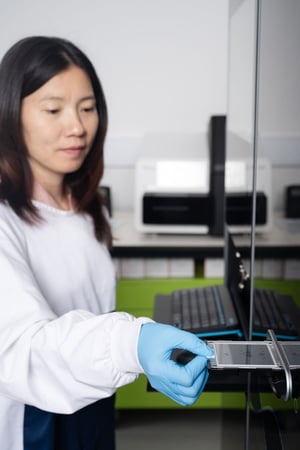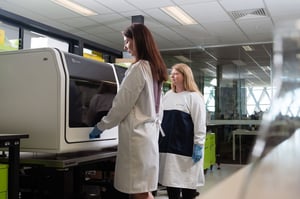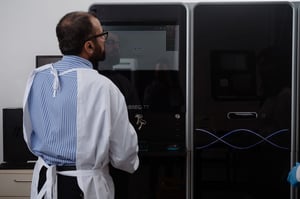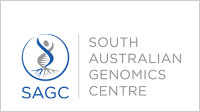
SAGC Collaborative Projects
- 01 iPSC-DERIVED NK CELLS
- 02 DRUG TARGETS FOR SANFILIPPO
- 03 BIOMARKER DISCOVERY IN SHEEP
- 04 TRAFFIC LIGHT MODEL FOR CML
- 05 BREAST CANCER STOMICS
- 06 INDIGENOUS GENOMICS
- 07 COVID-19 TESTING
- 08 RAPID VACCINE DEVELOPMENT
- 09 METABARCODING OF DUST
- 10 MICROBIOME-GUT-BRAIN AXIS
- 11 NEW TARGETS IN CANCER
A new model for generating iPSC-derived NK Cells validated using single cell RNA sequencing
Natural killer (NK) cells offer exciting potential for cancer immunotherapy because of their innate ability to target and destroy tumor cells without the need for prior sensitization. They can recognize and kill cancerous or virally infected cells through direct cytotoxicity and by releasing cytokines that modulate the immune response. NK cells are particularly effective at eliminating cancer cells that evade the adaptive immune system, and their function can be enhanced through techniques like chimeric antigen receptor (CAR) engineering.
NK cells are difficult to obtain from traditional donor sources because peripheral blood provides a limited supply, and the quality of NK cells varies between donors. When expanded in vitro, they can lose their effectiveness (functional exhaustion), and modifying them through gene editing is complex. These limitations make alternative sources, like iPSC-derived NK cells, highly appealing.
Recent work led by Dr. Gustavo R Rossi (Guimaraes Group - Translational innate immunotherapy, The University of Queensland) detailed a two-step method for generating high-purity Natural Killer cells from an induced pluripotent stem cell (iPSC) derived cell lines (iNK cells). These iNK cells displayed key NK cell markers and enhanced cytotoxicity, showed resilience to cryopreservation, and their cytotoxic potential was further improved by incorporating a chimeric antigen receptor (CAR) construct.
“A key advantage of the technology was being able to fix our cells from various sources at different time points, and safely ship them to the SAGC for barcoding and sequencing.” says Dr. Fernando Guimaraes.
Having a scalable and consistent source of iNK cells would help address current limitations in traditional NK cell sources, and has the potential to play an exciting role in cancer immunotherapies.
Single Cell RNA Sequencing using Parse Biosciences Evercodeᵀᴹ combinatorial barcoding technology: An important element of this study was comparing transcriptomic profiles of NK cells derived from iPSC with those derived from peripheral blood (PBMC) and cord blood units (CBU). Dr. Fernando Guimaraes and Gustavo became interested in using the Evercodeᵀᴹ technology for their experiment, because of the advantage of being able to fix and store cells from different sources across different time points, and batch together for processing and sequencing. This led them to the SAGC, who with the support of Dr. Jiyoti Verma (Field Application Specialist from Decode Science) conducted the combinatorial barcoding workflow and performed deep sequencing of the libraries on the MGI DNBSEQ G400.
Single Cell Data Processing: RNA sequencing data was analysed using Trailmaker, Parse Bioscience’s pipeline that aligns reads to a reference genome, generates gene count matrices and performs various QC steps, like filtering out low quality cells and removes doublets etc.
GR Rossi et al. Immunology & Cell Biology 2024; 1–11

Identification and validation of therapeutic targets for Sanfilippo Syndrome (MPS III)
Sanfilippo Syndrome is a paediatric lysosomal storage disorder that is commonly known as ‘childhood-onset dementia’, due to the severe cognitive impairment and neuronal loss associated with it. Children affected by this disorder experience symptoms such as hyperactivity, speech and hearing loss, sleep disturbances and motor impairment, all of which are followed by premature death around mid to late adolescence. While gene therapy has shown promising results in children diagnosed under the age of 2, most children are not diagnosed until 4 or 5 years of age. This highlights a critical need to identify new treatment options that could help manage symptoms, slow or stop disease progression and improve quality of life.
To begin to address this gap, the Laboratory for Human Neurophysiology and Genetics, led by Professor Cedric Bardy at SAHMRI and Flinders University, worked in collaboration with the SAGC. The aim was to understand the molecular changes underlying disease phenotypes and identify genetic targets for repurposed therapeutics. Using a human-derived neuronal model of Sanfilippo Syndrome along with state-of-the-art single-cell transcriptomic profiling, electrophysiology and machine learning, the team identified key phenotypes that may cause neurodegeneration.
As part of this project, the SAGC created mRNA libraries from single-nuclei extractions and sequencing. Together, we have sequenced multiple patient lines and identified dysregulated genes and pathways that can be targeted with repurposed drugs. This has helped Cedric’s team to identify and validate therapeutic targets for Sanfilippo Syndrome, which they hope will fast-track to clinical trials and improve the quality of life for patients.
LIVESTOCK PAIN BIOMARKER DISCOVERY
Sheep experience pain in response to necessary management practices like castration and tail docking, as well as during lambing and due to other natural hazards of life. At the very least that is acute pain but, if sheep are anything like humans and other mammals, then a proportion of sheep will also experience some form of persistent pathological pain.
To address wellbeing concerns around pain in sheep, objective pain measurement tools are needed to answer questions like: Do you have pain now? How much pain are you in? And have you had pain in the past? This then enables us to develop, and demonstrate the effectiveness of, pain mitigation strategies, as well as to provide objective evidence in support of claims of pain mitigation, and to support ongoing evaluation of best practice and evidence–based recommendations for managing sheep wellbeing.
Led by Professor Mark Hutchinson, researchers at the University of Adelaide’s Neuroimmunopharmacology Lab and Davies Livestock Research Centre are working to identify objective blood-based biomarkers of acute and persistent pain in sheep, with funding support from the Australian Research Council, Meat and Livestock Australia, the University of Adelaide’s Davies Livestock Research Centre, and the Livestock SA Sheep Industry Fund.
As part of this research program, the team have been working with SAGC to identify plasma and blood transcriptomic changes that occur in response to painful husbandry procedures, that could be used to diagnose/quantify acute or persistent pain in sheep.
Small RNA-seq of nearly 500 sheep plasma samples has been completed to date, alongside ongoing optimisation of protocols for sheep whole blood total RNA sequencing. By combining these blood transcriptomic data with blood cell phenotyping, brain and spinal cord histology and histochemistry, behaviour, and quantitative sensory testing data from their sheep trials, the team aim to not only identify novel objective pain biomarkers, but also build an integrated picture of the short- and long-term molecular, cellular, systems and behavioural consequences of these painful marking procedures, and the mechanisms underlying any transition to and maintenance of chronic pain, in sheep.

Genomic Precision in CML Biomarkers for Remission Success - Towards Lifelong Cancer Freedom
Chronic Myeloid Leukemia (CML) is a fatal blood cancer if left untreated, caused by the [t(9;22)(q34;q11)] translocation that generates the BCR::ABL1 fusion gene, leading to uncontrolled cell growth. Tyrosine kinase inhibitors (TKIs) have transformed CML therapy, increasing the 5-year survival rate to over 80%. However, reliance on lifelong TKI therapy poses challenges such as organ toxicity, financial strain, non-adherence, and reduced quality of life.
The CML laboratory at SAHMRI, led by Professor Tim Hughes, pioneered the paradigm-shifting concept of Treatment-Free Remission (TFR), enabling patients with optimal responses to TKIs to discontinue therapy. This approach improves quality of life and reduces long-term side effects. However, approximately half of the patients attempting TKI cessation relapse and require therapy resumption, whilst only 25% of all CML patients ultimately maintain durable TFR and can be considered cured. Achieving this goal remains a priority in CML management, but the absence of clinically validated predictive models leaves physicians unable to reliably assess relapse risk.
Groundbreaking work by Dr. Ilaria Pagani and colleagues has advanced this field by identifying the persistence of specific BCR::ABL1-positive cell populations as a key predictor of relapse. Using a novel lineage-specific PCR approach, they demonstrated that patients with detectable BCR::ABL1-positive granulocytes face a 100% relapse risk, whereas those without do not relapse. This insight led to the development of a clinically applicable "traffic light" model, enabling stratification of patients based on relapse risk. Such a tool could guide personalized discontinuation strategies, transforming TFR from a trial-and-error process into a precision-medicine driven approach.
Collaboration with the SAGC represented a critical step forward. Utilising SAGC's advanced genomic capabilities, the CML team identified the genomic breakpoint of the BCR::ABL1 fusion in CML patients, a cornerstone for precision monitoring of minimal residual disease. This detailed genomic mapping, specific for every patient, enhances the sensitivity of the predictive assay, enabling accurate detection of residual leukemic cells and informing relapse risk after TKI discontinuation.
Through this partnership, predictive tools for TFR will be advanced, and a framework for global implementation developed, significantly improving the management and outcomes of CML patients worldwide. Additionally, the biomarker will be validated in the context of the first Australian CML registry, ensuring that the findings are grounded in real-world data, advancing the care of CML patients globally.
Leveraging spatial transcriptomics to study breast tumours
Dr. Annette Lasham is a senior research fellow in the Department of Molecular Medicine and Pathology at the University of Auckland (Waipapa Taumata Rau). Along with Dr. Nicholas Knowlton, she co-leads the Digital Cancer Group, which works on a number of transformative studies with the ultimate goal of improving the diagnosis, treatment and outcomes for people with breast cancer in Aotearoa New Zealand.
The Digital Cancer Group works on the following:
-Breast cancer 'omics'
-Ductal Carcinoma in situ (DCIS)
-Breast cancer in young women- "Helena McAlpine Young Women's Breast Cancer Study"
-The role of the tumour supressor gene TP53 in breast cancer
-Analysis of cancer registry data
Dr. Lasham and her Team became interested in leveraging spatial transcriptomics to study breast tumours in young women; breast tumours are well known for having a high degree of both intertumoural and intratumoural heterogeneity. Therefore, performing traditional bulk RNA sequencing, which provides only an aggregation of gene expression across all cells in the tumor sample, is of limited value. Dr. Lasham landed on using Stereo-seqᵀᴹ (STOmics) because of its advantage with providing unbiased detection of the whole transcriptome at single cell resolution, enabling both centimeter-level panoramic field of view and subcellular resolution of gene expression in tissues. Via Decode Science, this led her to the SAGC, which through the acquisition of the DNBSEQ-T7 sequencer from MGI, became the first Genomics Core in Australia and New Zealand to offer STOmics at scale.
The experiment presented some challenges both in terms of scale and logistics, requiring an expert pathology team to perform the breast tumour sectioning in NZ and then shipping tissue-mounted slides to the SAGC for processing and sequencing.
The STOmics technology requires mounting tissue to specialised slides with nanoscale patterned grids of barcoded probes that capture mRNA and transfer information about location when reverse transcribed. Frozen tissue mounted slides can be safely shipped and processed, but time is key, as they need to be processed within 4 weeks before the RNA quality starts to be compromised.
“Our large spatial omics experiment had plenty of moving parts; the SAGC Team was able to handle the complexities to process and deliver our results on time.”
Overall, the team processed and sequenced 3 batches of STOmics slides from Dr. Lasham’s team. Each tissue sample required a tremendous amount of sequencing coverage (1 billion reads) per 1 cm² of tissue. For analysis, the SAGC bioinformatics team provided their support using SAW (Stereo-seq Analysis Workflow) that maps sequenced reads to their spatial location on the tissue section, quantifies gene expression and combines microscope images to overlay the data to generate interactive visualisations as part of the standard pipeline.
Cutting edge technology such as STOmics has the power to transform the understanding of fundamental processes in cancer, and thus diagnosis, treatment and management of the disease. The SAGC is excited by the potential insights Dr Lasham and her team will gain from these studies and is looking forward to working with them on future projects.
.png?width=948&height=351&name=Dr.%20Annette%20Lasham%20is%20a%20senior%20research%20fellow%20in%20the%20Department%20of%20Molecular%20Medicine%20and%20Pathology%20at%20the%20University%20of%20Auckland%20(Waipapa%20Taumata%20Rau).png)
ALIGN - PROPHECY STUDY
2023 saw the establishment of the South Australian node of the Australian Alliance for Indigenous Genomics (ALIGN), on the back of the successful 2021 Genomics Health Futures Mission grant to advance the benefits of Genomic Medicine for Aboriginal and Torres Strait Islander peoples.
Key priorities of the SA node, which is partially led by SAGC, revolve around extensive multi-omics analyses in the PROPHECY (Predicting Renal, Ophthalmic and Heart Events in the Aboriginal Community) study, Aboriginal-led policy development for Indigenous Genomics projects in SA and capacity development of a SA Indigenous genomics workforce. To help facilitate and guide this work, a South Australian Aboriginal Governance Committee has been established to provide Aboriginal insight and oversight into culturally safe genomics research practices so that we can work towards prioritising community benefit, health and wellbeing. The PROPHECY study is the largest longitudinal study of diabetes in Aboriginal Australians ever conducted. PROPHECY aims to understand why Aboriginal people get type II diabetes at a much younger age, and why they experience associated complications such as kidney disease and blindness at a much younger age than non-Aboriginal Australians.
A multi-omics approach will be applied to the PROPHECY study, encompassing DNA, RNA and methylome sequencing, as well as proteomics and metabolomics. Dr. Marlie Frank joined SAGC in 2023 as the SA Indigenous Genomics Coordinator. This is a joint appointment between SAGC and Aboriginal Health Equity, SAHMRI. Marlie has family connections through both the Kaurna and Yorta Yorta people and is an early career researcher, with a PhD in genomics, she will play a central role in co-ordinating activities, including sample analysis, workshops and scholarships as the representative of the SA node. Building an Indigenous genomics workforce and leaders of the future is a key priority for ALIGN in South Australia.
.png?width=1000&height=500&name=Heading%20(1).png)
COVID-19 SCREENING IN WASTEWATER FOR SA WATER
People who have COVID-19 will excrete fragments of the SARS-CoV-2 virus through faecal waste or other bodily fluids into the wastewater stream through the sewerage system. A wastewater surveillance program therefore provides another mechanism through which community transmission can be monitored to complement clinical surveillance. The point of difference for wastewater surveillance is that it does not rely on clinical presentation by individuals. Wastewater surveillance will detect virus fragments from people who are weakly symptomatic or asymptomatic. The use of wastewater surveillance for detecting and quantifying the presence of SARS-CoV-2 virus fragments was expanded in 2022 to identify the variants of the virus circulating in the community in a manner that is independent of clinical presentation by individuals.
The aim was to provide a complementary source of information to analysis of variants detected from sequencing of clinical isolates. In South Australia, SA Water, SA Health and the SAGC ran a PCR-based screening wastewater surveillance program over the course of a year, whereby samples were collected from the major metropolitan wastewater treatment plants twice a week. These plants service about 65% of the SA population. PCR products from these samples were submitted to SAGC for sequencing. The resulting data produced was used by SA Health to assess changes in prevalence of variants and to monitor the appearance of new variants of concern (results are shown in the figure 1).
.png?width=1000&height=500&name=Heading%20(3).png)
Rapid vaccine development for pandemic preparedness
Emergence of COVID-19 and the ensuing pandemic has demonstrated the continued threat infectious diseases can pose to our health, economy, and lifestyle and highlighted the importance of vaccines as a countermeasure. COVID-19 vaccines were developed and approved in approximately 350 days, which was 5-10 times faster than ever before. However, even greater speed is needed, and 100-days for vaccine development is the current target. Achieving this goal will require a shift in current vaccine paradigms and development of new flexible, rapid, scalable technologies.
The Sementis viral vector vaccine platform (SCV) has been designed to deliver safe, versatile, and scale-able vaccines and is being positioned for pandemic preparedness. Sementis and the Experimental Therapeutics Laboratory at the University of South Australia (UniSA) have worked together to develop a multi-pathogen Chikungunya and Zika virus vaccine and a first-generation COVID-19 vaccine to demonstrate the immunogenicity of the vaccine platform and utility in infectious disease. UniSA has further collaborated with Sementis, as part of a broader global network to position the vaccine platform for pandemic preparedness. This included supporting the introduction of new technology to enable rapid construction and characterisation of new vaccines.
UniSA selected SAGC to provide genomic services to demonstrate vaccine quality and safety. The proximity of the UniSA and SAGC teams facilitated easy access to leading genomics services, expertise, and real-time knowledge sharing. This enabled UniSA to demonstrate the feasibility of rapid new vaccine construction and a suite of analytical tools for future vaccine development. This outcome supports the positioning of SCV for new vaccine readiness within 100 days of pandemic pathogen antigen identification. The services provided by SAGC, and accessibility to leading genomics capability will continue to support vaccine development in the Experimental Therapeutics Laboratory.
Professor John Hayball and Dr Tamara Cooper (Experimental Therapeutics Laboratory, UniSA)
.png?width=1000&height=500&name=Heading%20(4).png)
THE SECRET HIDDEN IN DUST
Assessing the potential to use biological and chemical properties of the airborne fraction of soil for provenance assignment and forensic casework.
The airborne fraction of soil (dust) is both ubiquitous in nature and contains localised biological and chemical signatures, making it a potential medium for forensic intelligence. Metabarcoding of dust can yield biological communities unique to the site of interest, similarly, geochemical analyses can uncover elements and minerals within dust that can be matched to a geographic location. Combining these analyses presents multiple lines of evidence as to the origin of dust collected from items of interest. Dr. Jennifer Young is a DNA forensic technology research associate who lead a team where environmental dust samples were collected from belongings to determine whether bacterial and fungal communities in dust.
Dust and soil were collected from three sites with differing soil properties across South Australia. The resulting ITS and 16S sequencing data, generated at the SAGC, showed that it was possible to perform analysis from a single swabbed sample and that there were unique biological and chemical signatures between sites. When modelling bacterial and fungal diversity, Dr. Jennifer Young and team found samples were correctly predicted using dust 67% and 56% of the time and using soil 56% and 22% of the time for bacteria and fungi communities respectively. This proof-of-concept study found that metabarcoding of dust samples can generate bacteria and fungi community profiles that are unique to sites. While there is still a long way to go in this field, both metabarcoding and biogeochemical analyses of dust samples show potential for applications in forensic science.
Nicole R. Foster et. al, 2023, The secret hidden in dust: Assessing the potential to use biological and chemical properties of the airborne fraction of soil for provenance assignment and forensic casework, Forensic Science International: Genetics, Volume 67
.png?width=1000&height=500&name=Heading%20(5).png)
Chronic Visceral Pain and Irritable Bowel Syndrome
Irritable Bowel Syndrome (IBS) is a chronic disorder of the gastrointestinal tract affecting ~11% of the global population. Chronic visceral pain (CVP) is the most debilitating symptom associated with IBS. Despite this burden of disease, effective therapies for CVP associated with IBS are lacking. The first step in finding new treatments is understanding how pain from the gut is generated and transmitted to the brain via the microbiome-gut-brain axis and determining how these processes change in IBS. The Visceral Pain Research Group, led by Professor Stuart Brierley at SAHMRI is working in conjunction with SAGC to fill this knowledge gap. The goal is to identify changes in the molecular profile of precise cell types within the microbiome-gut-brain axis to determine how changes to these molecular profiles drive altered function and generate the abnormal pain signalling characteristic of IBS.
Using well-established models of IBS, in combination with state-of-the-art techniques (including genetic approaches, retrograde nerve tracing and FACS sorting), the Visceral Pain Research Group has isolated key cell types in the microbiome-gut-brain axis. The SAGC has created mRNA-Seq libraries from these single cell suspensions and have been sequencing them since the project’s inception. Together, we have processed more than a dozen experimental cohorts and are currently working through the bioinformatic analysis to interpret our results. With this ground-breaking project, we aim to identify novel targets and therapeutic strategies to relieve CVP, ultimately improving the quality of life of IBS patients.
.png?width=1000&height=500&name=Heading%20(7).png)
Novel Metabolic Therapies for Blood and Brain Cancer
The genes encoding isocitrate dehydrogenase 1 and 2 (IDH1/2) are mutated in brain cancer and leukaemia and drive the production of the oncometabolite (R)-2-hydroxyglutarate (R-2HG). However, specific differences between these two mutations with targetable implications have not been described. Dr Dan Thomas is a clinician and researcher who runs the Myeloid Metabolism Laboratory at SAHMRI. His team has recently discovered a novel susceptibility specifically for IDH1 mutation (mIDH1) by identifying the lipid synthesis enzyme ACC1 (acetyl CoA carboxylase 1) as a synthetic lethal target, published recently in Cancer Discovery and highlighted as one of the most important papers for 2023 by the European Cancer Association. By analyzing the metabolome of primary patient cells, his team identified a mIDH1-specific reduction in fatty acids compared to healthy progenitor cells that was not observed in IDH2-mutant cancer. Moreover, mIDH1 cells exhibited an increase in acyl-carnitine linked fatty acids destined for the mitochondria, indicating a switch to beta-oxidation. Overall, their data show that mIDH1 cancer cells have a higher dependency on both exogenous and de novo fatty acids than mIDH2 cancers.
This suggests that differences in intracellular localization between cytoplasmic IDH1 and mitochondrial IDH2 can have profound effects on metabolic phenotypes. These insights are important because it demonstrates novel targets for IDH1 mutant cancers beyond the production of the oncometabolite (R)-2-hydroxyglutarate, and offers hope for designing an ultra-precision approach encompassing diet and targeted therapy for cancer patients with IDH1, but not IDH2, mutant cancers. This is clinically relevant because emerging results from clinical trials testing mutant IDH inhibitors, such as ivosidenib, do not always result in tumour regression despite marked decreases in the oncometabolite. Dan's research suggests other metabolic dependencies beyond the Warburg effect, depending on somatic mutation context, such as mitochondrial-driven beta oxidation are also involved in cancer metabolism. This paper reinforces other recent studies supporting the notion that many cancers are not dependent on ATP or carbon supply for growth but are desperate for an adequate supply of re-usable NADPH (via NADH) and are prepared to sacrifice both de novo and exogenous fatty acids to guarantee this.
-1.png?width=1000&height=500&name=Heading%20(6)-1.png)




.jpg?width=793&height=595&name=IMG_3966%20(1).jpg)
